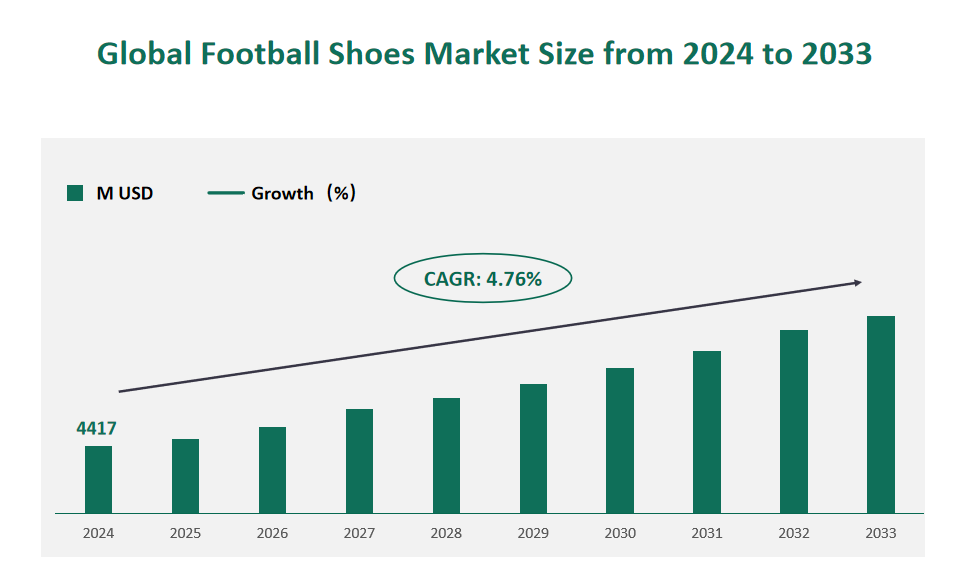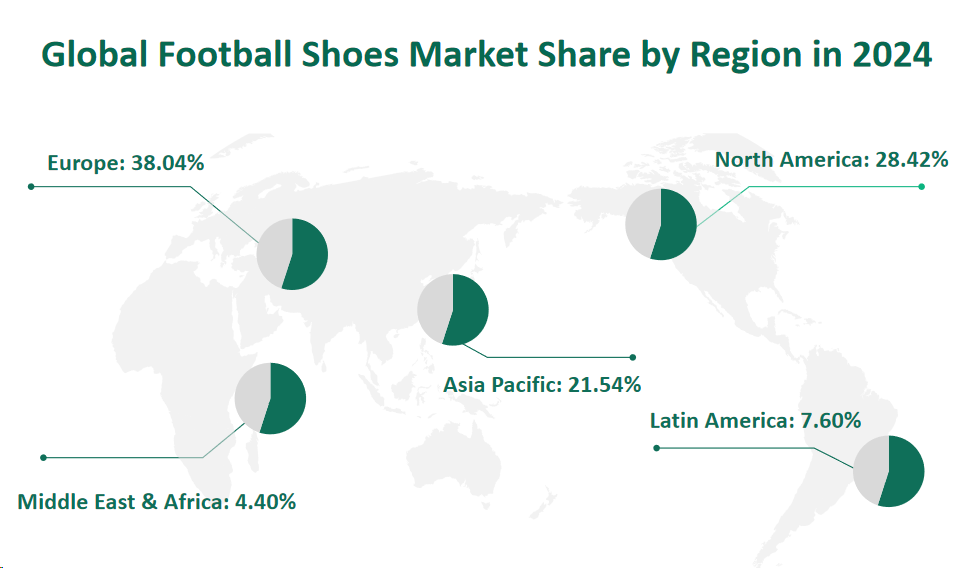1 Global Football Shoes Market Size (Value) and CAGR (2024-2033)
In 2024, the global football shoes market is projected to reach a value of 4,417.0 million USD, with a Compound Annual Growth Rate (CAGR) of 4.76% from 2024 to 2033.
Football shoes, also known as soccer cleats or soccer boots, are specialized footwear designed for the sport of football. They are typically characterized by lightweight construction, durable materials, and cleated soles that provide traction and stability on grass or turf surfaces.
Figure Global Football Shoes Market Size (M USD) and CAGR 2024-2033

2 Football Shoes Market Growth Drivers and Restraints
The football shoes market is experiencing significant growth, driven by a multitude of factors. The unparalleled popularity of football globally serves as the primary catalyst, with the sport commanding a massive following and increasing participation rates. This widespread engagement translates into a burgeoning demand for specialized footwear designed to enhance performance on the field.
The constant evolution in shoe technology, including the use of advanced materials and innovative designs, has led to products that offer improved comfort, durability, and performance. These technological advancements have not only attracted professional athletes but also a broader demographic of sports enthusiasts.
The market is also influenced by the growing trend of health and fitness consciousness among the global population, which has increased the engagement in sports activities, including football. This trend, coupled with the rising disposable income in emerging economies, has bolstered the market’s growth. Furthermore, the increasing participation of women in football has opened up new avenues for market expansion, as it necessitates the development of gender-specific footwear.
Despite these drivers, the market faces certain challenges that act as restraints. One of the primary constraints is the regional disparity in the popularity and participation in football. In some countries, economic conditions, lack of infrastructure, and low interest in the sport limit the potential for market growth.
The rise of modern entertainment activities, such as video gaming and digital platforms, has led to a shift in consumer preferences, with a segment of the population opting for indoor activities over outdoor sports like football. This shift has the potential to impact the demand for football shoes. Lastly, the market is also affected by the fluctuating economic conditions and changing consumer preferences, which can influence the sales of sports equipment.
3 Football Shoes Market Challenges and Restraints
The football shoes market is characterized by rapid technological innovations and dynamic corporate activities that shape its competitive landscape. Technological advancements have been at the forefront of market growth, with companies investing heavily in research and development to create high-performance football shoes. These innovations include the use of synthetic materials that offer superior ball control and water resistance, the incorporation of advanced cushioning systems for improved comfort, and the design of soles with enhanced traction and stability.
Corporate mergers and acquisitions and restructuring activities play an important role in shaping the market. Major brands like Nike, Adidas, and Puma have expanded their market share through strategic acquisitions, partnerships, and licensing agreements. These activities have not only helped companies to diversify their product portfolios but also to penetrate new markets and strengthen their global presence. For instance, the acquisition of smaller brands or technology companies has enabled these corporations to incorporate cutting-edge technologies into their products, thereby maintaining a competitive edge in the market.
Moreover, the market has witnessed a trend of collaborations between football shoe manufacturers and professional football clubs or athletes. These partnerships enhance brand visibility and allow companies to test and refine their products under real-game conditions. Additionally, the rise of e-commerce has provided new opportunities for companies to reach consumers directly, bypassing traditional retail channels and offering a more personalized shopping experience.
4 Global Football Shoes Market Size and Share by Type in 2024
The global Football Shoes market is segmented by type, with each type catering to different playing conditions and preferences. In 2024, the market is forecasted as follows:
FG Football Shoes: Forecasted to reach 2,299.9 million USD, accounting for the largest share of the market. FG shoes are designed for firm natural grass and feature molded studs for optimal grip and stability.
SG Football Shoes: Expected to reach 434.5 million USD, these shoes are meant for soft or wet ground and have longer studs for better penetration and stability.
AG Football Shoes: Projected at 732.7 million USD, AG shoes are suitable for artificial grass and have short, hollow studs for even grip and a lightweight feel.
TF Football Shoes: Anticipated to reach 653.3 million USD, TF shoes are designed for turf and have a higher number of shorter studs to distribute pressure evenly.
IC Football Shoes: Forecasted at 296.6 million USD, IC shoes are for indoor courts and have a flat, non-marking outsole for grip on smooth surfaces.
Table Global Football Shoes Market Size and Share by Type in 2024
Type | Market Size (M USD) 2024 | Market Share 2024 |
FG Football Shoes | 2299.9 | 52.07% |
SG Football Shoes | 434.5 | 9.84% |
AG Football Shoes | 732.7 | 16.59% |
TF Football Shoes | 653.3 | 14.79% |
IC Football Shoes | 296.6 | 6.71% |
5 Global Football Shoes Market Sales and Share by Application in 2024
The global football shoes market is segmented by application into two primary categories: Sports Enthusiasts and Professional Athletes.
For Sports Enthusiasts, the market is projected to reach a significant value, reflecting the vast number of amateur players and casual sports participants. In 2024, the sales for this segment are forecasted to be 52,304 thousand pairs, contributing to the majority of the market share. This demand is driven by the general public’s interest in the sport for recreational purposes, the desire for equipment that enhances performance, and the influence of professional football culture on consumer preferences.
On the other hand, the Professional Athlete segment, though smaller in volume, represents a high-value market due to the specialized and premium nature of the products used by professional players. The forecast for 2024 estimates sales of 2,537 thousand pairs for professional athletes. This segment is characterized by a focus on performance, technology, and the endorsement by professional players, which often sets industry standards and trends.
The football shoes for both applications are designed to meet the rigorous demands of the sport. For sports enthusiasts, the shoes are made to be durable, comfortable, and affordable, while still offering the necessary traction and support. Professional athletes, however, require shoes with cutting-edge technology, such as enhanced grip, lighter materials for speed, and specialized designs that cater to their specific playing styles and positions on the field.
Table Global Football Shoes Market Sales and Share by Application in 2024
Application | Market Sales (K Paris) 2024 | Market Share 2024 |
Sports Enthusiasts | 52304 | 95.37% |
Professional Athlete | 2537 | 4.63% |
6 Global Football Shoes Market Size and Share by Region in 2024
The global football shoes market is also segmented by region, with each region presenting unique market dynamics and growth potentials. In 2024, the regional market sizes are as follows:
North America: Projected to reach 1,255.4 million USD, the North American market is influenced by the growing popularity of soccer alongside traditional American sports. The region’s market is characterized by a strong preference for performance footwear and a growing demand for professional-quality products.
Europe: With a market size of 1,680.4 million USD, Europe leads the global market due to the continent’s deep-rooted football culture and the presence of top football leagues. The market here is mature, with a high demand for both professional and recreational football shoes.
Asia-Pacific: Forecasted at 951.2 million USD, the Asia-Pacific region is experiencing rapid growth, driven by increasing disposable incomes and a surge in sports participation, especially in countries like China and India.
Latin America: Estimated at 335.5 million USD, the Latin American market is passionate about football, with a strong base of both professional athletes and enthusiasts. The region’s market is growing but faces challenges such as economic instability.
Middle East and Africa: Projected to reach 194.4 million USD, this region has seen a growing interest in football, with increasing investments in sports infrastructure and a rising middle class with a taste for international sports.
Figure Global Football Shoes Market Share by Region in 2024

7 Major Players in Global Football Shoes Market
7.1 Nike
Company Profile: Nike, established in 1964 and headquartered in the USA, is a global leader in the design, marketing, and distribution of athletic footwear, apparel, and equipment. The company’s extensive product line caters to a wide range of sports, including football, with a strong focus on innovation and performance.
Business Overview: Nike’s football shoes are renowned for their advanced technology and design, targeting both professional athletes and sports enthusiasts. The company’s commitment to research and development has led to products that enhance performance and provide superior comfort.
Product Offered: Nike offers a variety of football shoes, including the Vapor Edge Pro 360, designed with a revamped upper for support and a conventional lacing system for secure fitting. The brand is also known for its Phantom Luna boot, specifically crafted for women’s football, featuring the Nike Cyclone 360 traction pattern for agility and precision.
2024 Revenue and Gross Margin: In 2024, Nike is projected to achieve a revenue of $1,593.2 million with a gross margin of 43.80%.
7.2 Adidas
Company Profile: Adidas, founded in 1949 and based in Germany, is a multinational corporation that designs, manufactures, and markets athletic and sports lifestyle products. The company is known for its wide range of footwear, apparel, and accessories, including football shoes.
Business Overview: Adidas has a strong presence in the football industry, offering products that cater to various levels of play, from amateur to professional. The company’s focus on sustainability and innovation is evident in its product development and marketing strategies.
Product Offered: Adidas’ football shoes lineup includes the ADIZERO Electric Snack Attack American Football Cleats, featuring a synthetic upper for a contoured fit and a cleated outsole for turf traction. The brand also offers the ‘Triunfo Dorado’ signature F50 boot, designed for Lionel Messi, with unique tech specifications.
2024 Revenue and Gross Margin: Adidas is expected to generate a revenue of $1,055.8 million in 2024, with a gross margin of 46.74%.
7.3 Puma
Company Profile: Puma, established in 1948 and headquartered in Germany, is a prominent sports brand that designs and manufactures footwear, apparel, and accessories for various sports, including football.
Business Overview: Puma has a significant share in the football shoes market, offering products that blend style with performance. The company’s association with international football teams and players enhances its brand visibility and appeal.
Product Offered: Puma’s football shoes include the ULTRA MATCH, a signature boot for Christian Pulisic, featuring a lightweight mesh upper with GripControl skin for stability and a TPU SPEEDPLATE outsole for traction.
2024 Revenue and Gross Margin: Puma anticipates a revenue of $439.7 million in 2024, with a gross margin of 45.82%.





